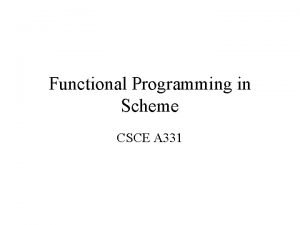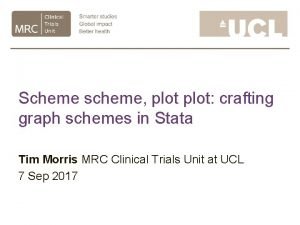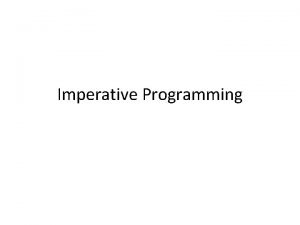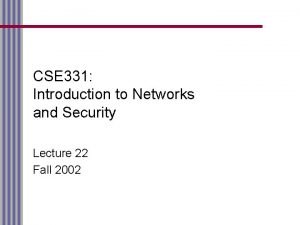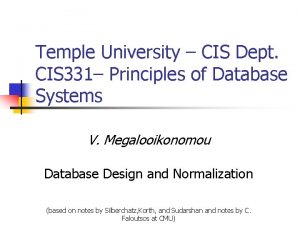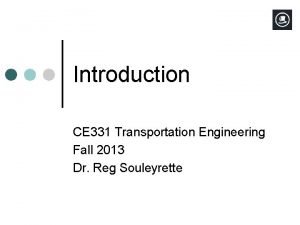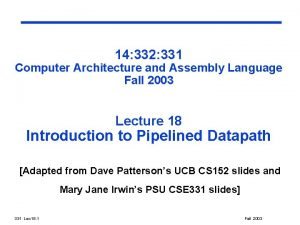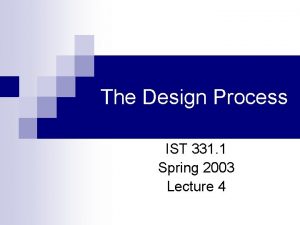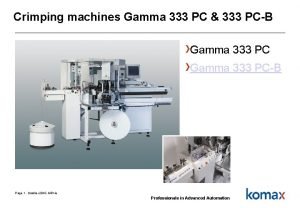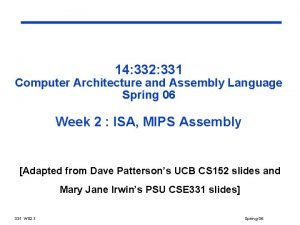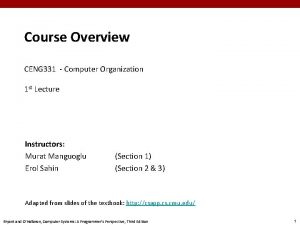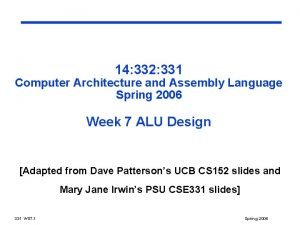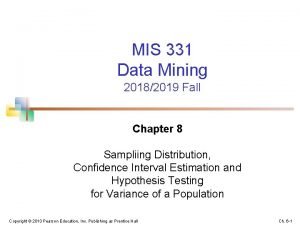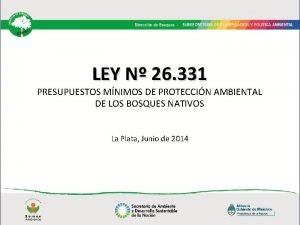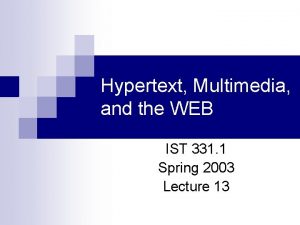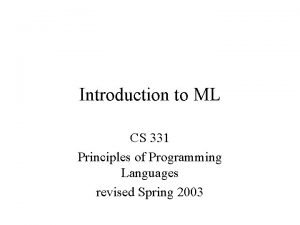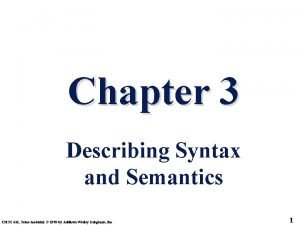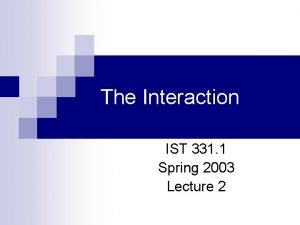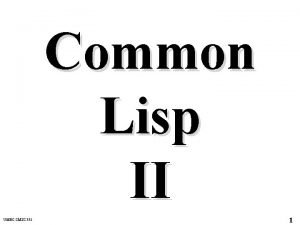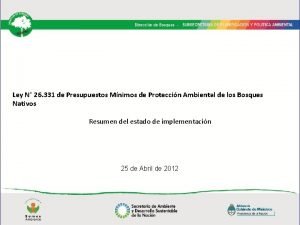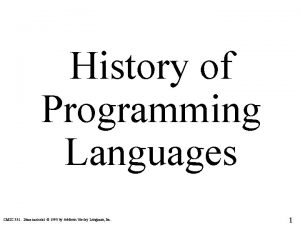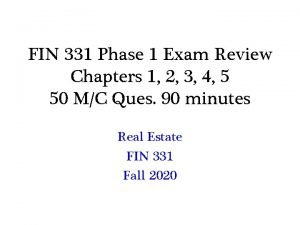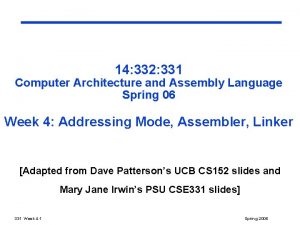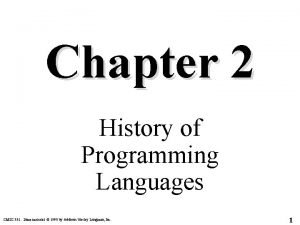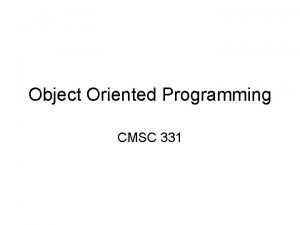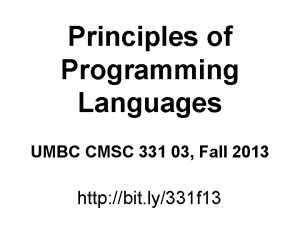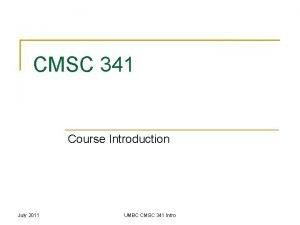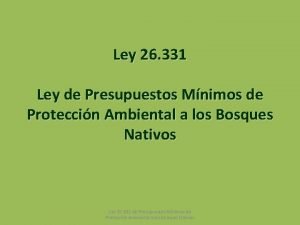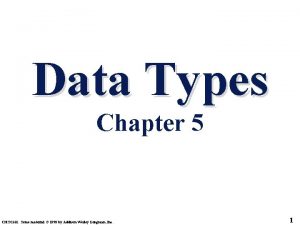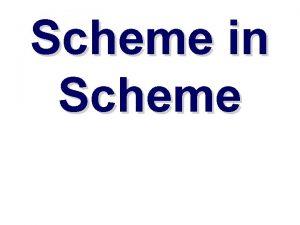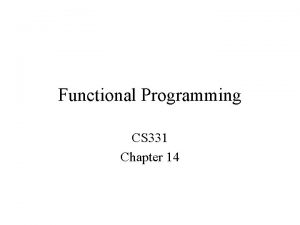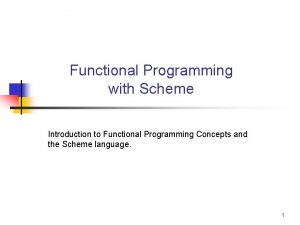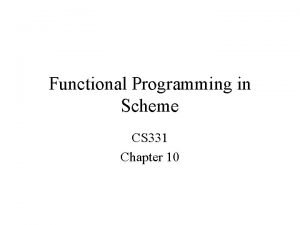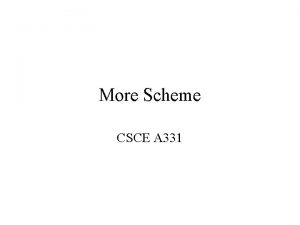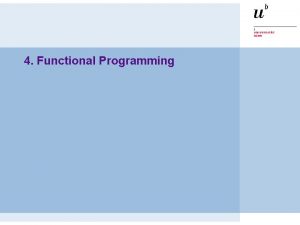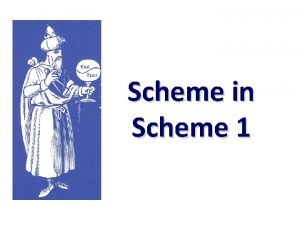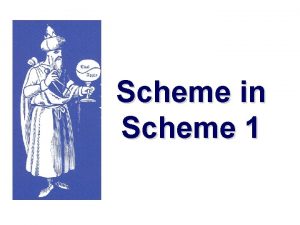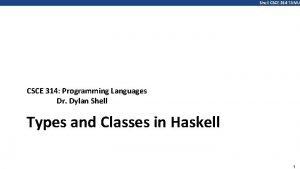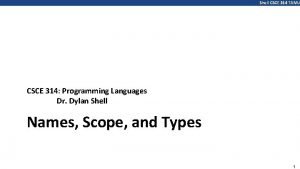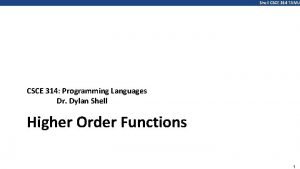Functional Programming in Scheme CSCE A 331 Functional







































- Slides: 39

Functional Programming in Scheme CSCE A 331

Functional Programming • Online textbook: http: //www. htdp. org/ • Original functional language is LISP – LISt Processing – The list is the fundamental data structure – Developed by John Mc. Carthy in the 60’s • Used for symbolic data processing • Example apps: symbolic calculations in integral and differential calculus, circuit design, logic, game playing, AI • As we will see the syntax for the language is extremely simple – Scheme • Descendant of LISP

Functional Languages • “Pure” functional language – Computation viewed as a mathematical function mapping inputs to outputs – No notion of state, so no need for assignment statements (side effects) – Iteration accomplished through recursion • In practicality – LISP, Scheme, other functional languages also support iteration, assignment, etc. – We will cover some of these “impure” elements but emphasize the functional portion • Equivalence – Functional languages equivalent to imperative • Core subset of C can be implemented fairly straightforwardly in Scheme • Scheme itself implemented in C • Church-Turing Thesis

Lambda Calculus • Foundation of functional programming • Developed by Alonzo Church, 1941 • A lambda expression defines – Function parameters – Body • Does NOT define a name; lambda is the nameless function. Below x defines a parameter for the unnamed function:

Lambda Calculus • Given a lambda expression • Application of lambda expression • Identity • Constant 2:

Lambda Calculus • Any identifier is a lambda expression • If M and N are lambda expressions, then the application of M to N, (MN) is a lambda expression • An abstraction, written where x is an identifier and M is a lambda expression, is also a lambda expression

Lambda Calculus Examples

Lambda Calculus First Class Citizens • Functions are first class citizens – Can be returned as a value – Can be passed as an argument – Can be put into a data structure as a value – Can be the value of an expression ((λx·(λy·x+y)) 2 1) = ((λy· 2+y) 1) = 3

Lambda Calculus Functional programming is essentially an applied lambda calculus with built in - constant values - functions E. g. in Scheme, we have (* x x) for x*x instead of λx·x*x

Functional Languages • Two ways to evaluate expressions • Eager Evaluation or Call by Value – Evaluate all expressions ahead of time – Irrespective of if it is needed or not – May cause some runtime errors • Example (foo 1 (/ 1 x)) Problem; divide by 0

Lambda Calculus • Lazy Evaluation – Evaluate all expressions only if needed (foo 1 (/ 1 x)) ; (/ 1 x) not needed, so never eval’d – Some evaluations may be duplicated – Equivalent to call-by-name – Allows some types of computations not possible in eager evaluation • Example – Infinite lists • E. g, . Infinite stream of 1’s, integers, even numbers, etc. – Replaces tail recursion with lazy evaluation call – Possible in Scheme using (force/delay)

Running Scheme for Class • A version of Scheme called Racket (formerly PLT/Dr Scheme) is available on the Windows machines in the NSB/ENGR Labs • Download: http: //racket-lang. org/ • Unix, Mac versions also available if desired

Racket • You can type code directly into the interpreter and Scheme will return with the results:


Make sure right Language is selected Use the “Pretty Big” language choice – it is closer to Scheme than others

Racket – Loading Code • You can open code saved in a file. Racket uses the extension “. rkt” so consider the following file “factorial. rkt” created with a text editor or saved from Racket: 2: Run 1: Open (define factorial (lambda (n) (cond ((= n 1) 1) (else (* n (factorial (- n 1)))) ) 3: Invoke functions

Functional Programming Overview • Pure functional programming – No implicit notion of state – No need for assignment statement • No side effect – Looping • No state variable • Use Recursion • Most functional programming languages have side effects, including Scheme – Assignments – Input/Output

Scheme Programming Overview - Refreshingly simple - Syntax is learned in about 10 seconds - Surprisingly powerful - Recursion - Functions as first class objects (can be value of an expression, passed as an argument, put in a data structure) - Implicit storage management (garbage collection) - Lexical scoping - Earlier LISPs did not do that (dynamic) - Interpreter - Compiled versions available too

Expressions • Syntax - Cambridge Prefix – Parenthesized – (* 3 4) – (* (+ 2 3) 5) – (f 3 4) • In general: – (function. Name arg 1 arg 2 …) • Everything is an expression – Sometimes called s-expr (symbolic expr)

Expression Evaluation • Replace symbols with their bindings • Constants evaluate to themselves – 2, 44, #f – No nil in Racket; use ‘() • Nil = empty list, but Racket does have empty • Lists are evaluated as function calls written in Cambridge Prefix notation (+ 2 3) (* (+ 2 3) 5)

Scheme Basics • Atom – Anything that can’t be decomposed further • a string of characters beginning with a letter, number or special character other than ( or ) • e. g. 2, #t, #f, “hello”, foo, bar • #t = true • #f = false • List – A list of atoms or expressions enclosed in () – (), empty, (1 2 3), (x (2 3)), (()()())

Scheme Basics • S-expressions – Atom or list • () or empty – Both atom and a list • Length of a list – Number at the top level

Quote • If we want to represent the literal list (a b c) – Scheme will interpret this as apply the arguments b and c to function a • To represent the literal list use “quote” – (quote x) x – (quote (a b c)) (a b c) • Shorthand: single quotation mark ‘a == (quote a) ‘(a b c) == (quote (a b c))

Global Definitions • Use define function (define f 20) (define evens ‘(0 2 4 6 8)) (define odds ‘(1 3 5 7 9)) (define color ‘red) (define color blue) (define num f) (define num ‘f) (define s “hello world”) ; Error, blue undefined ; num = 20 ; symbol f ; String

Lambda functions • Anonymous functions – (lambda (<formals>) <expression>) – (lambda (x) (* x x)) – ((lambda (x) (* x x)) 5) 25 • Motivation – Can create functions as needed – Temporary functions : don’t have to have names • Can not use recursion

Named Functions • Use define to bind a name to a lambda expression (define square (lambda (x) (* x x))) (square 5) • Using lambda all the time gets tedious; alternate syntax: (define (<function name> <formals>) <expression 1> <expression 2> …) Last expression evaluated is the one returned (define (square x) (* x x)) (square 5) 25

Conditionals (if <predicate> <expression 1> <expresion 2>) - Return value is either expr 1 or expr 2 (cond (P 1 E 1) (P 2 E 2) (Pn En) (else En+1)) - Returns whichever expression is evaluated

Common Predicates • Names of predicates end with ? – Number? : checks if the argument is a number – Symbol? : checks if the argument is a symbol – Equal? : checks if the arguments are structurally equal – Null? : checks if the argument is empty – Atom? : checks if the argument is an atom • Appears undefined in Racket but can define ourselves – List? : checks if the argument is a list

Conditional Examples • • (if (equal? 1 2) ‘x ‘y) (if (equal? 2 2) ‘x ‘y) (if (null? ‘()) 1 2) (cond ((equal? 1 2) 1) ((equal? 2 3) 2) (else 3)) • (cond ((number? ‘x) 1) ((null? ‘x) 2) ((list? ‘(a b c)) (+ 2 3)) ) ; y ; x ; 1 ; 3 ; 5

Dissecting a List • Car : returns the first argument – (car ‘(2 3 4)) – (car ‘((2) 4 4)) – Defined only for non-null lists • Cdr : (pronounced “could-er”) returns the rest of the list – Racket: list must have at least one element – Always returns a list • (cdr ‘(2 3 4)) • (cdr ‘(3)) • (cdr ‘(((3)))) • Compose • (car (cdr ‘(4 5 5))) • (cdr (car ‘((3 4))))

Shorthand • • (cadr x) = (car (cdr x)) (cdar x) = (cdr (car x)) (caar x) = (car x)) (cddr x) = (cdr x)) (cadar x) = (car (cdr (car x))) … etc… up to 4 levels deep in Racket (cddadr x) = ?

Why Car and Cdr? • Leftover notation from original implementation of Lisp on an IBM 704 • CAR = Contents of Address part of Register – Pointed to the first thing in the current list • CDR = Contents of Decrement part of Register – Pointed to the rest of the list

Building a list • Cons – Cons(truct) a new list from first and rest – Takes two arguments – Second should be a list • If it is not, the result is a “dotted pair” which is typically considered a malformed list – First may or may not be a list – Result is always a list

Building a list X = 2 and Y = (3 4 5) : (cons x y) (2 3 4 5) X = () and Y =(a b c) : (cons x y) (() a b c) X = a and Y =() : (cons x y ) (a) • What is – (cons 'a (cons 'b (cons 'c '()))) – (cons ‘a (cons ‘b ‘())) (cons ‘c ‘()))

Numbers • Regular arithmetic operators are available +, -, *, / – May take variable arguments (+ 2 3 4), (* 4 5 9 11) • (/ 9 2) 4. 5 ; (quotient 9 2) 4 • Regular comparison operators are available < > <= >= = • E. g. (= 5 (+ 3 2)) #t = only works on numbers, otherwise use equal?

Example • Sum all numbers in a list (define (sumall list) (cond ((null? list) 0) (else (+ (car list) (sumall (cdr list)))))) Sample invocation: (sumall ‘(3 45 1))

Example • Make a list of n identical values (define (makelist n value) (cond ((= n 0) '()) (else (cons value (makelist (- n 1) value)) ) In longer programs, careful matching parenthesis.

Example • Determining if an item is a member of a list (define (member? item list) (cond ((null? list) #f) ((equal? (car list) item) #t) (else (member? item (cdr list))) ) ) Scheme already has a built-in (member item list) function that returns the list after a match is found

Example • Remove duplicates from a list (define (remove-duplicates list) (cond ((null? list) '()) ((member? (car list) (cdr list)) (remove-duplicates (cdr list))) (else (cons (car list) (remove-duplicates (cdr list)))) ) )
 Scheme functional programming
Scheme functional programming 3 domain scheme and 5 kingdom scheme
3 domain scheme and 5 kingdom scheme Stata graph schemes download
Stata graph schemes download Pyramid scheme vs ponzi
Pyramid scheme vs ponzi Scheme programming
Scheme programming Cse 331
Cse 331 Cis 331
Cis 331 In 331 bce, alexander the great successfully invaded egypt.
In 331 bce, alexander the great successfully invaded egypt. Ce 331
Ce 331 14:332:331
14:332:331 Ist 331
Ist 331 Komax gamma 333
Komax gamma 333 14:332:331
14:332:331 Cow.ceng.metu.edu tr
Cow.ceng.metu.edu tr 14:332:331
14:332:331 Mist-331
Mist-331 Ley 26 331
Ley 26 331 Transportation planing
Transportation planing Ist 331
Ist 331 14:332:331
14:332:331 2011 plc (cs) 331
2011 plc (cs) 331 Pred-331
Pred-331 Cmsc 331
Cmsc 331 Ist 331
Ist 331 Cmsc 331
Cmsc 331 Ley 26 331
Ley 26 331 Ssis 331
Ssis 331 Cmsc 331
Cmsc 331 Affirmative easement
Affirmative easement Anth 331
Anth 331 14:332:331
14:332:331 Cmsc 331
Cmsc 331 Cmsc 331
Cmsc 331 Umbc languages
Umbc languages Cmsc 341
Cmsc 341 Ley 26 331
Ley 26 331 Uw cse 331
Uw cse 331 Cmsc 331
Cmsc 331 What is system program
What is system program Linear vs integer programming
Linear vs integer programming
